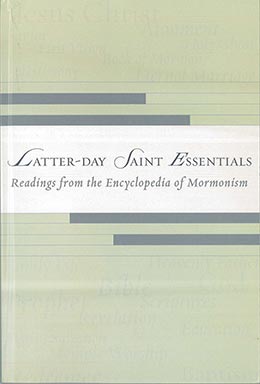Purpose of Earth Life
James P. Bell
James P. Bell, “Purpose of Earth Life,” in Latter-day Saint Essentials: Readings from the Encyclopedia of Mormonism, ed. John W. Welch and Devan Jensen (Provo, UT: BYU Studies and the Religious Studies Center, Brigham Young University, 2002), 94–6.
Latter-day Saint prophets have affirmed the purpose of life within the framework of three questions: (1) Whence did we come? (2) Why are we here? (3) What awaits us hereafter? The scriptural context of these questions is assurance of the eternal character of the soul and of the creation of the earth as a place for the family of God.
All men and women have lived as spirit beings in a premortal state, and all are the spiritual offspring of God (Abr. 3:21–22). In that world all the family of God were taught his plans and purposes. “At the first organization in heaven we were all present, and saw the Savior chosen and appointed and the plan of salvation made, and we sanctioned it” (Teachings, p. 181). All the spirit children of God developed various degrees of intelligence and maturity. Those who voluntarily subscribed to the conditions of mortality were embodied and made subject to the Light of Christ “that lighteth every man that cometh into the world” (D&C 93:2). So that earth life may be a probation, a veil of forgetfulness has been drawn over the former life.
In mortality, at least six purposes are opened to mankind:
1. To be given a body, whose experiences and maturation, and eventual permanent resurrection, are essential to the perfecting of the soul. “We came to this earth that we might have a body and present it pure before God in the celestial kingdom” (Teachings, p. 181).
2. To grow in knowledge, and develop talents and gifts. “If you wish to go where God is, you must be like God, or possess the principles which God possesses, for if we are not drawing towards God in principle, we are going from Him and drawing towards the devil” (Teachings, p. 216).
3. To be tried and tested. “We will prove them herewith,” says the record of Abraham, “to see if they will do all things whatsoever the Lord their God shall command them” (Abr. 3:25). Through mortality one experiences contrasts and opposites—health and sickness, joy and sadness, blessings and challenges—and thus comes to know to prize the good. “Adam fell that men might be; and men are, that they might have joy” (2 Ne. 2:23). Such joy, as Elder B. H. Roberts of the Seventy wrote, can come only from “having sounded the depths of the soul, from experiencing all emotions of which mind is susceptible, from testing all the qualities and strength of the intellect” (Roberts, p. 439).
4. To fill and fulfill the missions and callings that were conferred or preordained. Latter-day Saints often speak of earth life as a second estate and allude to the promise given to and through Abraham that “they who keep their second estate [i.e., fulfill the purposes of mortality] shall have glory added upon their heads for ever and ever” (Abr. 3:26).
5. To exercise agency without memory of the premortal existence, thus to “walk by faith” and have the “realities anticipated in the spirit world renewed and confirmed.”
6. To establish the foundations of eternal family relationships, first as sons and daughters, then as fathers and mothers. The united family is the epitome of the fulfilled and saintly life.
The life to come is the extension and fulfillment of the mortal sojourn: to enter into and live forever in the presence of God. But probation does not end with death. Nor do opportunities to hear, accept, and apply the truths and powers of Christ. Indeed, Joseph Smith taught that even for the faithful, “it is not all to be comprehended in this world; it will be a great work to learn our salvation and exaltation even beyond the grave” (Teachings, p. 348). He added that when the spirit is separated from the body, the process is somewhat impeded, hence the importance of using the time while in mortality, for redemption, and the folly of procrastination of repentance and renewal.
In all this, the continuity of the former life with this one, and in turn this life with the next, is clearly taught. The tendency of much religion, Eastern and Western—to divide life into two worlds and to hold that they are utterly distinct and unlike—is reversed. Life is change, transformation, and exaltation. Mortality is a dress rehearsal for the next world. There, light, glory, and dominion will be conferred in fulness on those who have fulfilled the words of eternal life in this world, and are therefore prepared for eternal life in the world to come.
Bibliography
Roberts, B. H. “Modern Revelation Challenges Wisdom of Ages to Produce More Comprehensive Conception of the Philosophy of Life.” Liahona, the Elders’ Journal 20 (May 8, 1923): 433–39.
